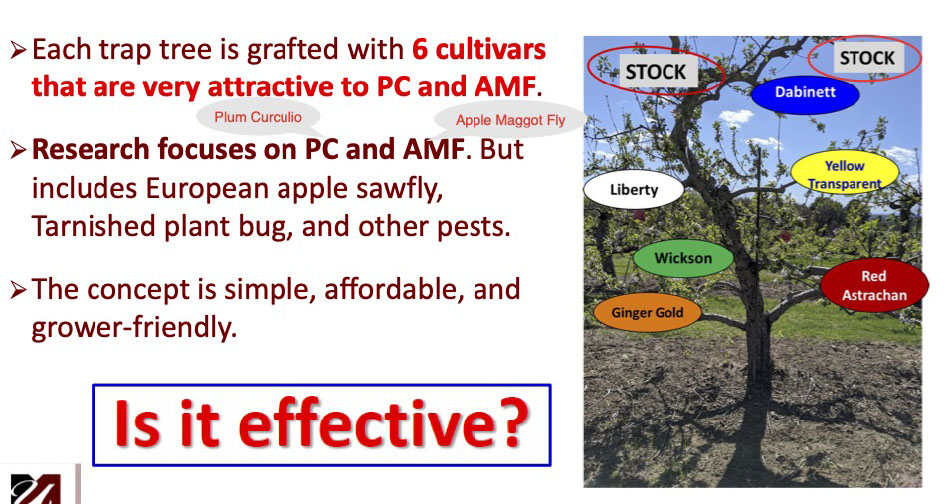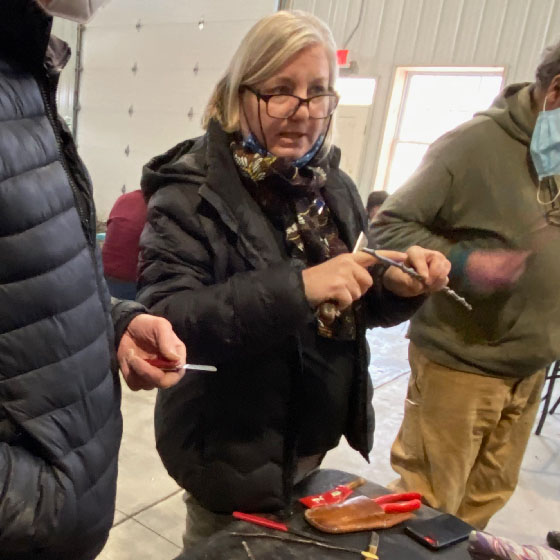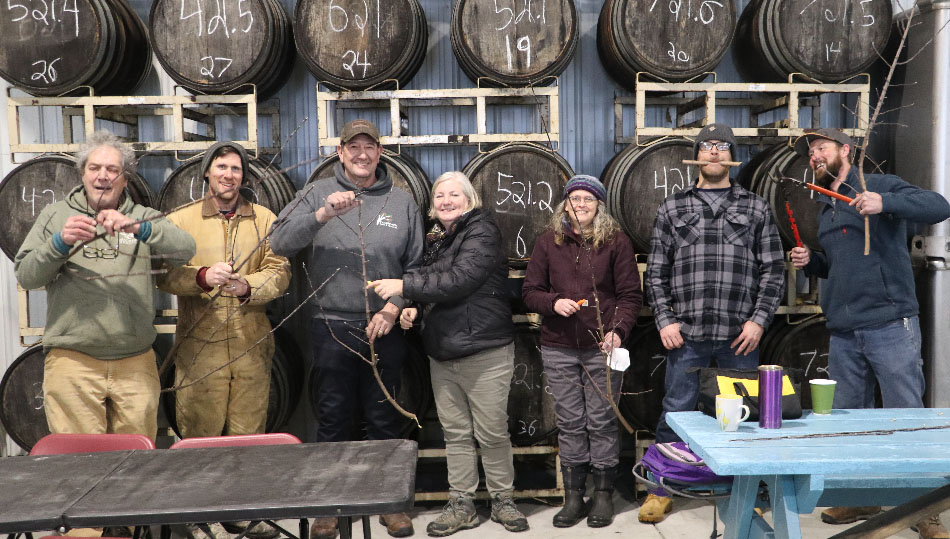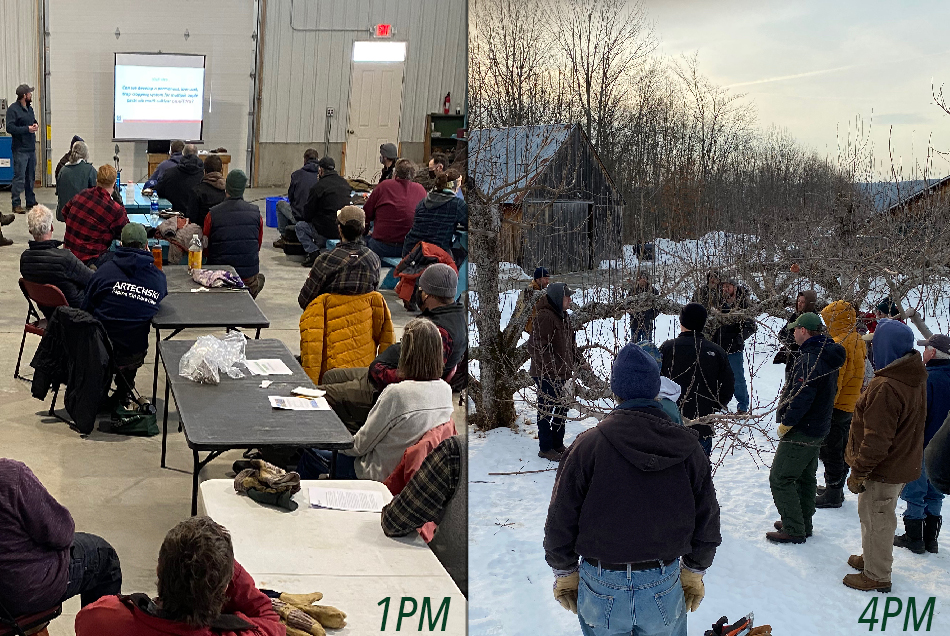Fruit growing changes as research and experiment yield new knowledge. So in wintertime, orchard people attend lots of meetings and educational events. Recently at Poverty Lane/Farnum Hill there was a very cool grafting workshop to teach a newly proven method of pest control. It involves grafting to make selected trees into "attractant trees," at the very edges of orchards.
Ace grafters Raul and Mary Godinez came from their nursery in VA to teach. There was a big turnout, a couple of talks followed by lots of knife work, very hands-on. Band-aids were distributed to each work-table! Beginners and seasoned grafters all learned new things.
Ace grafters Raul and Mary Godinez came from their nursery in VA to teach. There was a big turnout, a couple of talks followed by lots of knife work, very hands-on. Band-aids were distributed to each work-table! Beginners and seasoned grafters all learned new things.
 At this event, a multi-variety grafting technique was introduced and recommended to growers not involved in the research. Every grower urgently wants to minimize pesticide use - whether organic pesticides or synthetic. Research constantly pursues specific ways to do that.
At this event, a multi-variety grafting technique was introduced and recommended to growers not involved in the research. Every grower urgently wants to minimize pesticide use - whether organic pesticides or synthetic. Research constantly pursues specific ways to do that. But between concept and use comes a long experimental period, when certain willing growers repeatedly risk some crop damage to test unproven methods. (At our farm we have decades of history in hosting & performing orchard experiments monitored by ag researchers - as do pals at Apple Hill {NH} & Ricker Hill {ME}). So it was a thrill for us trial orchardists when the experiment's crew came from UMass and UNH to explain and promote "attractant trees" to all orchardists. Here's the key slide:

OK so yes it is effective, once growers can graft. Because it demonstrably slashes the amount of pesticide (whether "organic" or "synthetic") needed to control apple-wrecking critters. The attractant trees look odd, growing several different apple varieties that bloom at different times. Each variety entices particular creatures at the particular time they move into orchards. Fortunately, these insects don't pause to think "this is too good to be true!" Once they crowd into tiny portions of an orchard, and are killed in those places, the rest of the orchard won't need any more "treatment" against those pests. Environmentally good, financially good, and time-saving! The scary testing phase is over.
Onward, from principle to practice. Below, Mary shows basics:
 Practice time starts here. More will happen at home.
Practice time starts here. More will happen at home. Dozens of people practiced their knife-work: here are two. The afternoon progressed as grafters lined up for direct coaching from the pros. Samples of different grafts were passed from hand to hand (see photos below.)
Dozens of people practiced their knife-work: here are two. The afternoon progressed as grafters lined up for direct coaching from the pros. Samples of different grafts were passed from hand to hand (see photos below.)In waning outdoor light, a crowd watched as Raul Godinez demonstrated practical solutions to classic growers' problems: What to do if you need to get some grafts in early, during winter dormancy? What to do if your stored grafting scions come out looking weak during the easiest time-window, as "bark is slipping" in spring? What to do in summer, if you want to get more grafts going without waiting through another dormancy cycle? Raoul's deft knife-work made all sorts of grafts look doable - assuming enough physical practice beforehand!

Many new grafters left for home with sparks of ambition in their eyes. They looked ready to bring bundles of practice wood indoors, maybe put in serious couch time perfecting their cuts.
Grafting, as we've pointed out before, feels like magic. This workshop felt like wizard school!
A few more photos:





Weird-looking, but effective! Above see an "attractant tree" in the making. It will look better with leaves and blossoms... But still strange. We can't apologize for the geekiness of this story - nothing complex happens without geekiness! We are proud!
 Steve Wood (FHCiders), Shane Teveris (FHCiders), Raul Godinez (Countryside Nursery), Mary Godinez (Countryside Nursery), Heather Bryant (UNH Extension), Dan Birnstihl (UNH), Jeremy Delisle (UNH Extension). Not pictured: the lead scientist, Jaime Pinero, Professor of Entomology, (UMass Extension), Anna Wallingford (UNH Extension.)
Steve Wood (FHCiders), Shane Teveris (FHCiders), Raul Godinez (Countryside Nursery), Mary Godinez (Countryside Nursery), Heather Bryant (UNH Extension), Dan Birnstihl (UNH), Jeremy Delisle (UNH Extension). Not pictured: the lead scientist, Jaime Pinero, Professor of Entomology, (UMass Extension), Anna Wallingford (UNH Extension.)

